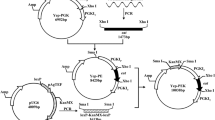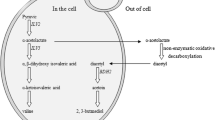Abstract
Superoxide dismutase (SOD) is a significant antioxidant, but unlike glutathione (GSH), SOD cannot be secreted into beer by yeast cells during fermentation, this directly leads to the limited application of SOD in beer anti-aging. In this investigation, we constructed the SOD1 secretion cassette in which strong promoter PGK1p and the sequence of secreting signal factor from Saccharomyces cerevisiae were both harbored to the upstream of coding sequence of SOD1 gene, as a result, the obtained strains carrying this cassette successfully realized the secretion of SOD1. In order to overcome the limitation of previous genetic modification on yeast strains, one new comprehensive strategy was adopted targeting the suitable homologous sites by gene deletion and SOD1 + GSH1 co-overexpression, and the new strain ST31 (Δadh2::SOD1 + Δilv2::GSH1) was constructed. The results of the pilot-scale fermentation showed that the diacetyl content of ST31 was lower by 42 % than that of the host, and the acetaldehyde content decreased by 29 %, the GSH content in the fermenting liquor of ST31 increased by 29 % compared with the host. Both SOD activity test and the positive and negative staining assay after native PAGE indicated that the secreted active SOD in the fermenting liquor of ST31 was mainly a dimer with the size of 32,500 Da. The anti-aging indexes such as the thiobarbituric acid and the resistance staling value further proved that the flavor stability of the beer brewed with strain ST31 was not only better than that of the original strain, but also better than that of the previous engineering strains. The multi-modification and comprehensive improvement of the beer yeast strain would greatly enhance beer quality than ever, and the self-cloning strain would be attractive to the public due to its bio-safety.






Similar content being viewed by others
References
Akada R (2002) Genetically modified industrial yeast ready for application. J Biosci Bioeng 94(6):536–544
Blomqvist K, Suihko ML, Knowles J, Penttila M (1991) Chromosomal integration and expression of two bacterial α-acetolactate decarboxylase genes in brewer’s yeast. Appl Envir Microbiol 57(10):2796–2803
Burke D, Dawson D, Stearns T (2000) Yeast DNA isolations. In: Methods in yeast genetics. A cold spring harbor laboratory course manual. pp 109–111
Culotta VC, Yang M, O’Halloran TV (2006) Activation of superoxide dismutases: putting the metal to the pedal. Biochim Biophys Acta 1763:747–758
Donalies UEB, Stahl U (2002) Increasing sulphite formation in Saccharomyces cerevisiae by overexpression of MET14 and SSU1. Yeast 19(6):475–484
Douglas KT (1987) Mechanisms of action of glutathione-dependent enzymes. In: Meister A (ed) Advances in enzymology. John Wiley & Sons, New York, pp 103–167
Duong CT, Strack L, Futschik M, Katou Y, Nakao Y, Fujimura T, Shirahige K, Kodama Y, Nevoigt E (2011) Identification of Sc-type ILV6 as a target to reduce diacetyl formation in lager brewers’ yeast. Metab Eng 13(6):638–647
Fan X, He X, Guo X, Qu N, Wang Ch, Zhang B (2004) Increasing glutathione formation by functional expression of the γ-glutamylcysteine synthetase gene in Saccharomyces cerevisiae. Biotechnol Lett 26:415–417
Fierro-Risco J, Rincon AM, Benitez T, Codon AC (2013) Overexpression of stress-related genes enhances cell viability and velum formation in Sherry wine yeasts. Appl Microbiol Biotechnol 97(15):6867–6881
Fratelli M, Goodwin LO, Ørom UA, Lombardi S, Tonelli R, Mengozzi M, Ghezzi P (2005) Gene expression profiling reveals a signaling role of glutathione in redox regulation. Proc Natl Acad Sci USA 102:13998–14003
Grant CM, MacIver FH, Dawes IW (1998) Glutathione and catalase provide overlapping defenses for protection against hydrogen peroxide in the yeast Saccharomyces cerevisiae. Biochem Biophys Res Commun 253:893–898
Grigsby JH, Palamand SR (1976) The use of thiobarbituric acid as a mean of the degree of beer staling. Am Soc Brew Chem 34:89–98
Guo XX, Song HL, Jiang XZ, Huang JZ (2006) Construction of a Saccharomyces cerevisiae heterozygote strain with an ADH2 allele deletion. Chin Med Res Clinic 4(9):7–11
Hansen J, Kielland-Brandt MC (1996) Inactivation of MET10 in brewer’s yeast specifically increase SO2 formation during beer production. Nat Biotechnol 14:1587–1591
Ito H, Fukuda Y, Murata K, Kimura A (1983) Transformation of intact yeast cells treated with alkali cations. J Bact 153(1):163–168
Jezek P, Hlavatá L (2005) Mitochondria in homeostasis of reactive oxygen species in cell, tissues, and organism. Int J Biochem Cell Biol 37:2478–2503
Jiang K, Li Q, Gu GX (2007) Improvement in the anti-staling capability of beer by genetically modifying industrial brewing yeast with high glutathione content. Chin J Biotech 23(6):1071–1076
Karachitos A, Galganska H, Wojtkowska M, Budzinskaa M, Stobienia O, Bartosz G, Kmita H (2009) Cu, Zn-superoxide dismutase is necessary for proper function of VDAC in Saccharomyces cerevisiae cells. FEBS Lett 583(2):449–455
Li Y, Tie CJ, Wang ZX, Zhang BR, Zhu GJ (2002) Construction of diacetyl-low brewer΄s yeast. Liquor Making 29(6):77–79 (in Chinese)
Lu F, Wang Y, Bai D, Du L (2005) Adaptive response of Saccharomyces cerevisiae to hyperosmotic and oxidative stress. Process Biochem 40:3614–3618
Mu Q, Cai Y, Wang ZY, Zhang BR, Ren ZL (2009) Construction of industrial brewing yeast with high-SOD and low-diacetyl productivity using self-cloning technique. Food Sci 30(19):248–251 (in Chinese)
Ohtake Y, Watanabe K, Tezuka H, Ogata T, Yabuuchi S, Murata K, Kimura A (1989) Expression of the glutathione synthetase gene of Escherichia coli B in Saccharomyces cerevisiae. J Ferment Bioeng 68:390–394
O’Brien KM, Dirmeier R, Engle M, Poyton RO (2004) Mitochondria protein oxidation in yeast mutants lacking manganese-(MnSOD) or copper-and zinc-containing superoxide dismutase (CuZnSOD). J Biol Chem 279:51817–51827
Orna CH, Gisela S (2000) Roles of the glutathione-and thioredoxin-dependent reduction systems in the Escherichia coli and Saccharomyces cerevisiae responses to oxidative stress. Annu Rev Microbiol 54:439–461
Russell DW, Smith M, Williamson VM, Young ET (1983) Nucleotide sequence of the yeast alcohol dehydrogenase II gene. J Biol Chem 258(4):2674–2682
Sambrook J, Russell DW (2001) Molecular cloning, a laboratory manual, 3rd edn. Cold Spring Harbor Laboratory Press, New York
Schiestl RH, Gietz RD (1989) High efficiency transformation of intact yeast cells using single stranded nucleic acids as a carrier. Curr Genet 16(5–6):339–346
Shi WH, Lin HL, Sun ZJ, Chen GQ (2001) Mutant haploid by alcohol dehydrogenase II gene deletion of Saccharomyces cerevisiae. J Biol 18(5):18–20 (in Chinese)
Sone H, Fujii T, Kondo K, Shimizu F, Tanaka J, Inoue T (1988) Nucleotide sequence and expression of the Enterobacter aerogenes alpha-acetolactate decarboxylase gene in brewer’s yeast. Appl Envir Microbiol 54(1):38–42
St-Pierre J, Buckingham JA, Roebuck SJ, Brand MD (2002) Topology of superoxide production from different sites in the mitochondrial electron transport chain. J Biol Chem 277:44784–44790
Storz P (2006) Reactive oxygen species-mediated mitochondria-to-nucleus signaling: a key to aging and radical-caused diseases. Sci STKE 332:re3
Sturtz LA, Diekert K, Jensen LT, Lill R, Culotta VC (2001) A fraction of yeast Cu, Zn-superoxide dismutase and its metallochaperone, CCS, localize to the intermembrane space of mitochondria. A physiological role for SOD1 in guarding against mitochondrial oxidative damage. J Biol Chem 276:38084–38089
Swiegers JH, Capone DL, Pardon KH, Elsey GM, Sefton MA, Francis IL, Pretorius IS (2007) Engineering volatile thiol release in Saccharomyces cerevisiae for improved wine aroma. Yeast 24(7):561–574
Villa KD, Lee S, Masschelein CA, Goossens E, Debourg A, Masschelein CA (1995) Control of vicinal diketone production by brewer’s yeast. I. Effects of ILV5 and ILV3 gene amplification on vicinal diketone production and ILV enzyme activity. J Am Soc Brew Chem 53(2):49–53
Villanueba KD, Goossens E, Masschelein CA (1990) Subthreshold vicinal diketone levels in Lager brewing yeast fermentations by means of ILV5 gene amplification. J Am Soc Brew Chem 48(3):111–114
Wang DL, Song XL, Zhang WJ (2005) The study on the decrease of acetaldehyde in beer by molecular biological technique. Beer Sci Technol 12:18–23 (in Chinese)
Wang J, Shen N, Yin H, Liu C, Li Y, Li Q (2013) Development of industrial brewing yeast with low acetaldehyde production and improved flavor stability. Appl Biochem Biotechnol 169(3):1016–1025
Wang JJ, Wang ZY, He XP, Zhang BR (2012) Integrated expression of the α-amylase, dextranase and glutathione gene in an industrial brewer’s yeast strain. World J Microbiol Biotechnol 28(1):223–231
Wang ZY, He XP, Zhang BR (2007) Over-expression of GSH1 gene and disruption of PEP4 gene in self-cloning industrial brewer’s yeast. Int J Food Microbiol 119(3):192–199
Wang ZY, He XP, Liu N, Zhang BR (2008) Construction of self-cloning industrial brewing yeast with high-glutathione and low-diacetyl production. Int J Food Sci Tech 43(6):989–994
Wang ZY, Wang JJ, Liu XF, He XP, Zhang BR (2009) Recombinant industrial brewing yeast strains with ADH2 interruption by using self-cloning GSH1 + CUP1 cassette. FEMS Yeast Res 9(4):574–581
Wawryn J, Swieciło A, Bartosz G, Biliński T (2002) Effect of superoxide dismutase deficiency on the life span of the yeast Saccharomyces cerevisiae. An oxygen-independent role of Cu, Zn-superoxide dismutase. Biochim Biophys Acta 1570:199–202
Xie W-H, Yao J-F, Yuan Q-S (1988) Modification of pyrogallol autoxidation method for assay of superoxide dismutase. Chin J Pharm 19(5):217–220
Yamano S, Tanaka J, Inoue T (1994) Cloning and expression of the gene encoding α-acetolactate decarboxylase from Acetobacter aceti ssp. xylinum in brewer’s yeast. J Biotech 32:165–171
Yang TB, Mei SJ (1991) Comparison of positive staining and negative staining of superoxide dismutase. Prog Biochem Biophys 18(6):468–470
Yasuyuki O, Seizou Y (1991) Molecular cloning of the γ-glutamylcysteine synthetase gene (GSH-I) of Saccharomyces cerevisiae. Yeast 7:953–961
Yoshida S, Imoto J, Minato T, Ouchi R, Sugihara M, Imai T, Ishiguro T, Mizutani S, Tomita M, Soga T, Yoshimoto H (2008) Development of bottom-fermenting Saccharomyces strains that produce high SO2 levels, using integrated metabolome and transcriptome analysis. Appl Environ Microbiol 74:2787–2796
Zhang JN, He XP, Guo XN, Liu N, Zhang BR (2005) Genetically modified industrial brewing yeast with high-glutathione and low-diacetyl production. Chin J Biotechnol 21(6):942–946 (in Chinese)
Zhang Y, Wang ZY, He XP, Liu N, Zhang BR (2008) New industrial brewing yeast strains with ILV2 disruption and LSD1 expression. Int J Food Microbiol 123(1–2):18–24
Acknowledgments
Many thanks to all the members at the Microbiology Laboratory and the engineers at the Test Laboratory of Research and Development Center in Tsingtao Brewery Co., Ltd., for providing us the kind help on pilot-scale fermentation and tests of fermentation parameters.
Author information
Authors and Affiliations
Corresponding authors
Rights and permissions
About this article
Cite this article
Wang, Z., Bai, X., He, X. et al. Secretion expression of SOD1 and its overlapping function with GSH in brewing yeast strain for better flavor and anti-aging ability. J Ind Microbiol Biotechnol 41, 1415–1424 (2014). https://doi.org/10.1007/s10295-014-1481-9
Received:
Accepted:
Published:
Issue Date:
DOI: https://doi.org/10.1007/s10295-014-1481-9




